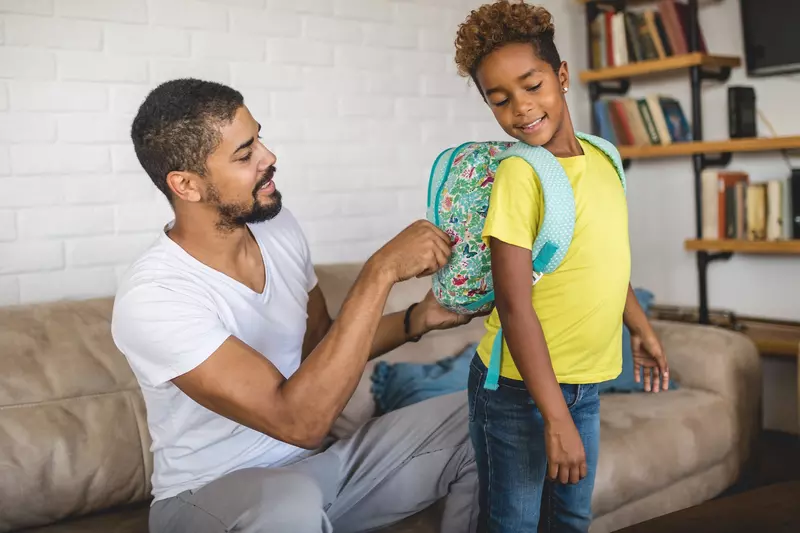- AdventHealth

As your child heads to school, their chances of encountering chronic low back pain, strains and more serious spinal conditions are high — and not always for reasons you might think. Taking a few simple steps can help your child ditch the distraction of back pain and focus on hitting the books.
AdventHealth experts regularly diagnose the causes and contributors to chronic neck and back pain in patients of all ages, and apply treatment plans for resolving these issues every day. If someone you know is experiencing debilitating discomfort due to a spine condition, it's worth seeking medical evaluation by a specialist who can help.
While simple muscle strains and sprains are neither uncommon nor unexpected in children, more serious spine issues such as spondylolysis and spondylolisthesis (slipped bone) are an increasing concern as kids grow to adulthood. In fact, kids 12 and older have an increased risk of back problems compared to those below that threshold, and nearly a third of all teenagers will suffer from recurring back pain at some point.
Kids Who Play a Single Sport Risk Overuse Injuries and Back Pain
If your child has a passion for soccer, tennis, track or other sports, help ensure they can enjoy their favorite pastime for the long term by making sure the frequency and duration of their workouts are within reason for both their capabilities and age. Excessive training should be avoided and improper techniques need to be addressed, while core-strengthening exercises including hamstring and hip flexor stretches should be part of their daily routine.
Kids should cross-train in another area (such as rowing) that will help them build and maintain core muscles while giving their body a break from repetitive actions associated with their chosen sport. In fact, some experts recommend keeping kids from specializing in any one sport prior to their late teens, so muscle development can take place evenly across different parts of the body.
Carrying Backpacks That Are Too Heavy
While the increasing use of e-books and iPads has helped lighten the load for some, other kids routinely lug backpacks as heavy as 30% or more of their own body weight. That's far too much for comfort, and a leading cause of back pain in school-age children.
An easy-to-follow guideline is to make sure your child's backpack weighs no more than 10–15% of their body weight. Just as important, backpacks need to be carried correctly on both shoulders and packed properly to ensure even weight distribution to reduce the likelihood of perpetually strained muscles. A backpack with a front strap across the student’s chest can ensure the weight of the bag is as close to the spine as possible, which will also reduce stress on back muscles.
Ensure Backpack Safety
Casual footwear isn't the best choice for that cross-campus commute. While flip flops may be favored footwear for students, they're less than ideal for trekking between classes if you want to avoid trips and falls, as well as chronic back pain. Suggest that your child save those flimsy slides for the dorm, and make sure they have one or more pairs of comfortable, supportive, well-fitting shoes for daily use.
Power of Positivity
If your child feels overwhelmed by schoolwork, is saddled with excessive pressure to excel or experiences lots of stress on a daily basis, this can contribute to perpetually tensed neck and back muscles. The truth is that a person's emotional well-being plays a significant role in how they experience and cope with all kinds of pain. Plus social isolation, exhaustion and depression may all contribute to weight gain, bone loss, muscle strength and back problems.
Encourage your teen to find positive ways to deal with stress such as regular exercise and maintaining physical fitness. These good habits can last a lifetime, and both children and adults who engage in regular aerobic activity tend to have a lower incidence of back pain.
Poor Posture Is Enemy Number One
Kids are learning new things every day at school, but don’t let them forget that you taught them to sit up straight. The way many students slump over their desks for hours puts them at risk for serious neck and back discomfort. Ensure your student knows the best sitting position to help them be more comfortable during those long nights of studying.
While there's little doubt that the chance of experiencing chronic back pain generally increases with age, the advantages of youth can only go so far in keeping your child's spine safe and strong. Regular exercise, injury prevention, sensible footwear, strong core muscles and a positive attitude are all keys to keeping kids and teens on track for a healthy future. Click here to learn more about spine care from the specialists at AdventHealth.


